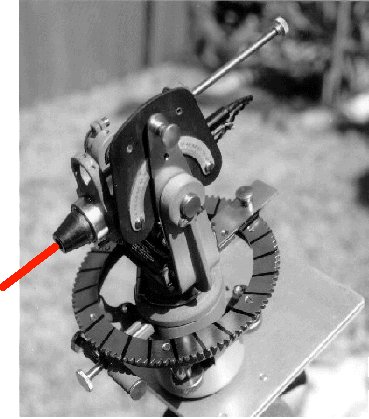- Details
- Hits: 18567
This Sundials for Starters appeared in The Compendium in March 2014
Robert L. Kellogg, Ph.D.
 In 1902 Alice More Earle in her book Sun-Dials and Roses of Yesterday commented:
In 1902 Alice More Earle in her book Sun-Dials and Roses of Yesterday commented:
“Of course, there are in the United States many houses that manufacture optical and mathematical instruments and also make sun-dials. There are also those who make and sell very pretty brass dials, made to look well … regardless of the shape of the gnomon or drawing of the hour lines. I know no individual, however, save Captain Bailey, who makes accurate sun-dials for all latitudes.” [Fig. 1 of Captain John S. Bailey, 19th century dial maker - Earle].
- Details
- Hits: 14758
 Eagle Scout Project by
Geno Chandler
Parker Middle School, Howell, MI
|
The "Human Sundial", technically called an analemmatic sundial, allows one's own shadow to cast the time of day. The sundial works with students of any height, where all they have to do is stand on the current day of year mark of a central walkway. The analemmatic sundial can be painted onto concrete or asphalt playgrounds or, using markers and a brick or paver-stone walkway, be designed for a flat, grassy area.
- Details
- Hits: 13459
Mechanical Dialing and a Laser Trigon
 By Robert Terwilliger
By Robert TerwilligerThe most popular ways to lay out sundials involves computation, geometry, or a combination of both. These methods assume the dial will be created on a regular surface, such as flat horizontal or vertical dials or circularly curved equatorial dials.
A less known method is mechanically drawing dial lines using a string or laser beam to project artificial “sunbeams” to show where light and shadow fall. This technique can be used on both regular and irregular surfaces. We start by describing the principles of a trigon.
- Details
- Hits: 15240
By Robert L. Kellogg, Ph. D.

Benjamin Banneker, 1731-1806 , is one of the nation's best-known African American inventors. He was born in Maryland and in 1791 played an important part in surveying the newly designed Federal Territory, now called the District of Columbia. In his youth, Banneker was inspired to build his own clock after an acquaintance gave him a watch. He took the watch apart to find out how it worked and made drawings of each component, and based on his drawings, he carved larger versions of the components out of wood and constructed a clock that kept accurate time for more than 50 years. As mathematician, he designed an Almanac that was a rival of Benjamin Franklin’s famous publication.
As astronomer, clockmaker, and mathematician, he was expected to know how to design sundials, although none exist bearing his mark. In an age before pocket calculators, how would Banneker design a sundial? The graphical method is available in modern texts such as Waugh’s 1973 classic “Sundials: Theory and Construction”. Want to lay out a horizontal sundial without sines, cosines, and tangents? Then this “Sundials for Starters” is for you.
- Details
- Hits: 23265
To make a dial that correctly tells standard time you will need to know your latitude for dial construction and longitude to determine the correction (time zone offset) between your dial and the time zone meridian (usually set every 15 degrees of longitude).
IMPORTANT Some maps will indicate longitudes in North American as negative, indicating that they are west of Greenwich. Other maps will indicate longitudes in North American as postive, declaring them "west longitude".
- Details
- Hits: 20133
Even if your dial includes the longitude correction, its timekeeping will vary throughout the year due to a phenomenon called The Equation of Time. Simply put, the apparent motion of the sun compared to your watch will cause your dial to appear as much as 16 minutes" fast" or "slow" at various times of the year.
The Equation of Time is caused by the combination of two effects: (a) by the earth's elliptical orbit where the laws of Kepler tell the earth to speed faster near the sun than away...that is, at perihelion in December the earth's orbital change is faster that during the June aphelion, and (b) the 23.44° tilt of the earth's axis from the elciptic plane of its orbit.
Page 2 of 2
